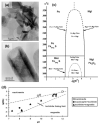Metal Chalcogenide-Hydroxide Hybrids as an Emerging Family of Two-Dimensional Heterolayered Materials: An Early Review
- PMID: 37834518
- PMCID: PMC10573794
- DOI: 10.3390/ma16196381
Metal Chalcogenide-Hydroxide Hybrids as an Emerging Family of Two-Dimensional Heterolayered Materials: An Early Review
Abstract
Two-dimensional (2D) materials and phenomena attract huge attention in modern science. Herein, we introduce a family of layered materials inspired by the minerals valleriite and tochilinite, which are composed of alternating "incompatible", and often incommensurate, quasi-atomic sheets of transition metal chalcogenide (sulfides and selenides of Fe, Fe-Cu and other metals) and hydroxide of Mg, Al, Fe, Li, etc., stacked via electrostatic interaction rather than van der Waals forces. We survey the data available on the composition and structure of the layered minerals, laboratory syntheses of such materials and the effect of reaction conditions on the phase purity, morphology and composition of the products. The spectroscopic results (Mössbauer, X-ray photoelectron, X-ray absorption, Raman, UV-vis, etc.), physical (electron, magnetic, optical and some others) characteristics, a specificity of thermal behavior of the materials are discussed. The family of superconductors (FeSe)·(Li,Fe)(OH) having a similar layered structure is briefly considered too. Finally, promising research directions and applications of the valleriite-type substances as a new class of prospective multifunctional 2D materials are outlined.
Keywords: Mössbauer spectroscopy; XPS; heterostructure; hydrothermal synthesis; layered minerals; tochilinite; two-dimensional materials; valleriite.
Conflict of interest statement
The authors declare no conflict of interest. The funders had no role in the design of the study; in the collection, analyses, or interpretation of data; in the writing of the manuscript; or in the decision to publish the results.
Figures















Similar articles
-
A new material built with alternating Cu sulfide and (Al,Mg) hydroxide molecular sheets: hydrothermal synthesis and selected characteristics.Nanoscale. 2024 Dec 12;16(48):22360-22373. doi: 10.1039/d4nr03144j. Nanoscale. 2024. PMID: 39545279
-
Specificity of the Thermal Stability and Reactivity of Two-Dimensional Layered Cu-Fe Sulfide-Mg-Based Hydroxide Compounds (Valleriites).ACS Omega. 2023 Sep 18;8(39):36109-36117. doi: 10.1021/acsomega.3c04274. eCollection 2023 Oct 3. ACS Omega. 2023. PMID: 37810731 Free PMC article.
-
Valleriite, a Natural Two-Dimensional Composite: X-ray Absorption, Photoelectron, and Mössbauer Spectroscopy, and Magnetic Characterization.ACS Omega. 2021 Mar 10;6(11):7533-7543. doi: 10.1021/acsomega.0c06052. eCollection 2021 Mar 23. ACS Omega. 2021. PMID: 33778265 Free PMC article.
-
2D compounds with heterolayered architecture for infrared photodetectors.Chem Sci. 2024 Sep 9;15(39):15983-6005. doi: 10.1039/d4sc03428g. Online ahead of print. Chem Sci. 2024. PMID: 39328196 Free PMC article. Review.
-
Physics and chemistry of layered chalcogenide superconductors.Sci Technol Adv Mater. 2012 Dec 28;13(5):054303. doi: 10.1088/1468-6996/13/5/054303. eCollection 2012 Oct. Sci Technol Adv Mater. 2012. PMID: 27877516 Free PMC article. Review.
References
-
- Xia Y., Gao W., Gao C. A Review on Graphene-Based Electromagnetic Functional Materials: Electromagnetic Wave Shielding and Absorption. Adv. Funct. Mater. 2022;32:2204591. doi: 10.1002/adfm.202204591. - DOI
Publication types
Grants and funding
LinkOut - more resources
Full Text Sources

